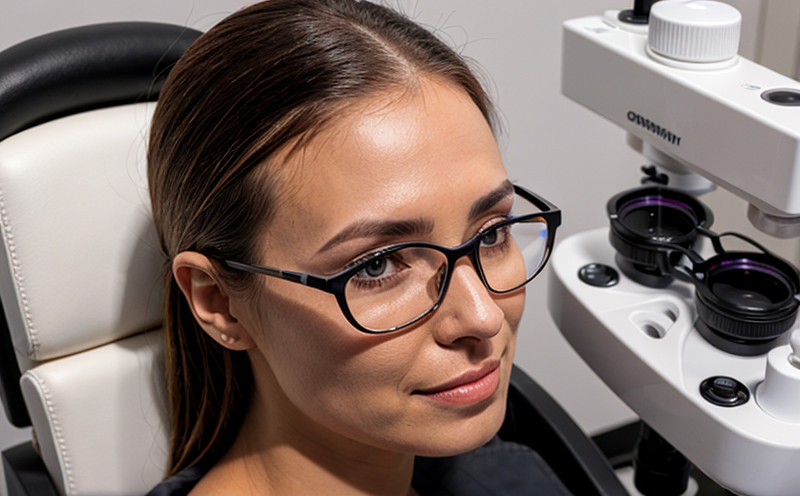USP Clarity and Color of Solution Testing
The United States Pharmacopeia (USP) sets high standards for purity and quality in pharmaceutical products. The clarity and color testing procedures are critical components to ensure that ophthalmic solutions meet the stringent requirements outlined by USP. This service ensures that ophthalmic products do not contain any impurities or particles that could affect the patient's health, as well as ensuring their visual appearance meets the specified criteria.
The clarity test evaluates the transparency of a solution to ensure there are no visible particulates or insoluble residues. The color test assesses whether the product adheres to the USP standards for hue and shade. These tests are essential because they directly impact patient safety, efficacy, and compliance with regulatory requirements.
The process begins with careful preparation of the sample. A suitable volume of the ophthalmic solution is transferred into a clear glass vial or cuvette, ensuring no air bubbles are present as this can distort clarity readings. The vials are then placed in an appropriate holder for testing on a spectrophotometer.
The spectrophotometric method measures light absorption at specific wavelengths to determine the color and clarity of the solution. For clarity, the instrument provides a measure of the turbidity, which is inversely proportional to the clarity value. For color determination, the wavelength range chosen aligns with USP specifications for ophthalmic products.
Quality control personnel at pharmaceutical companies rely on this service to ensure that new formulations meet regulatory standards before clinical trials and commercial release. This testing also helps in identifying any contamination issues early in production or during storage.
The accuracy of these tests is paramount, as they can influence the effectiveness of treatments for ocular conditions such as glaucoma. Any particulate matter could lead to irritation or infection, while incorrect color could indicate a formulation issue that needs correction.
Compliance with USP standards is not only crucial for maintaining product integrity but also necessary for regulatory approvals and market access. Many countries around the world use USP as their reference standard, making this service invaluable in ensuring global compliance.
The results from these tests are reported based on predetermined acceptance criteria outlined by USP. For clarity, a lower turbidity value indicates better quality, while color values should fall within defined ranges to meet specifications.
- Clarity: Measured in nephelometric turbidity units (NTU).
- Color: Reported as absorbance at specified wavelengths.
Industry Applications
In the pharmaceutical sector, particularly for ophthalmic products, clarity and color testing are fundamental. These tests help in ensuring product purity and visual appeal, which are critical aspects of patient safety and satisfaction.
The clarity test is especially important for solutions used during eye surgeries or those that come into direct contact with the ocular surface. Impurities can cause irritation, inflammation, or even infection, leading to severe health issues. Ensuring high clarity helps in reducing these risks.
Color testing ensures that ophthalmic products have the correct color and shade as specified by USP standards. Incorrect colors can indicate formulation errors, which could lead to ineffective treatments. This test is crucial for maintaining brand identity and ensuring patient trust.
R&D engineers use these tests to develop new formulations that meet or exceed USP requirements. By adhering to the specified parameters, they ensure their products are safe, effective, and reliable.
Quality managers rely on this service during quality assurance audits and batch release testing. It helps in maintaining consistent product quality across production batches, ensuring that every unit meets regulatory standards before being released into the market.
Quality and Reliability Assurance
- Consistency: Ensures that each batch of ophthalmic solutions has consistent clarity and color, which is critical for patient safety and satisfaction.
- Regulatory Compliance: Guarantees adherence to USP standards, ensuring products can be legally marketed worldwide.
- Patient Safety: By eliminating potential contaminants or particles that could harm patients, this service enhances overall patient safety.
- Brand Reputation: Maintaining consistent quality and appearance of ophthalmic solutions helps in building trust with customers and healthcare professionals.
Competitive Advantage and Market Impact
In the competitive pharmaceutical market, ensuring product quality through rigorous testing provides a significant advantage. Compliance with USP standards not only ensures regulatory approval but also enhances brand reputation and patient trust.
Patients are more likely to choose products that they know meet strict safety and efficacy criteria, increasing customer loyalty and potentially driving higher sales volumes.
Pharmaceutical companies that invest in advanced testing technologies and rigorous quality control measures can differentiate themselves from competitors. This differentiation can lead to increased market share and a stronger position in the global pharmaceutical industry.
The ability to consistently deliver high-quality products also opens up opportunities for international expansion, as many countries rely on USP standards for regulatory approvals.





